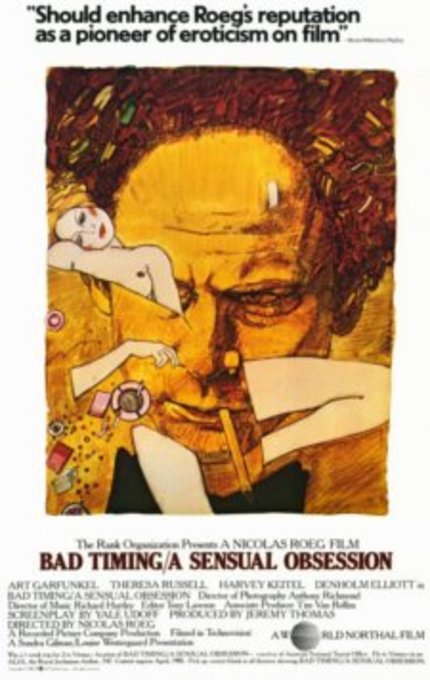Nicholas Roeg's BAD TIMING and the Art of the Bad Relationship

This post will remain at the top of the page for a single day.
There are countless films about obsessive relationships but one of the very best is Nicolas Roeg's 1980 film Bad Timing. Roeg's film is an absolutely beautiful work about the complex dynamics of an absolutely wretched relationship. Bad Timing is fiction, but like most great art, the film uses the tools of the medium to artfully probe the dark side of human behavior.
Bad Timing presents the tale of Alex Linden (Art Garfunkel), a famous psychiatrist working as a professor in Vienna. Alex meets a mysterious young woman named Elena (Theresa Russell). From the moment they meet, a sexual tension arises. Over time, the sexual tension turns into obsession as Alex becomes increasingly crazed and possessive over Elena. Eventually, the relationship turns into abusive, perverse disaster with Elena fighting for her life in an emergency room. Inspector Netusil (Harvey Keitel), a long-haired hipster American cop working in Vienna, is tasked with piecing together what happened to Elena, and attempts to grind down Alex.
Art Garfunkel is most famously known as half of the popular 60s folk group Simon & Garfunkel. Garfunkel also had a brief but interesting run as an actor, including roles in two Mike Nichols films: Catch 22 and Carnal Knowledge. In Bad Timing, Garfunkel goes for broke as a cold-blooded, chain-smoking psychopath with a big shock of red hair. The incongruity between Garfunkel's public image at the time and this cold nasty character adds to performance. If Garfunkel is icy cold in the film, Teresa Russell runs really, really hot. Bad Timing was Russell's third film performance. She was in her early 20s at the time, and conveyed a smooth of mix of sexual confidence and emotional vulnerability. The physical demands of both performances, including extensive nudity, gymnastic hip grinding, and fisticuffs, heighten the pitch. Harvey Keitel's performance as a Harvard-educated detective who unexplainedly ends up work for the Viennese police holds together the chaos as he explores facts and logistics of the alleged crime.
A large part of Bad Timing's appeal comes from the way in which it was assembled. The film was written and shot in a linear sequence. Once shooting was completed, the film was edited around Inspector Netusil's investigation of Alex Linden. As Netusil grills Alex about what happened to Elena, the film shifts into flashbacks of various moments in the relationship between Alex and Elena. The flashbacks provide clues about the arc of the relationship while also providing insight into Alex's psychology by revealing the truth or falsity of his answers. Netusil's inductive reasoning ultimately leads him to the truth, which is also revealed to the audience in one of the most notorious scenes in modern film history. Once again, Art Garfunkel's presence just adds to the cognitive dissonance.
Many, including this writer, first saw Bad Timing on a low-res VHS tape. There is no need to suffer the same indignity as Criterion released a flawless DVD with illuminating extras a few years ago. Seek out Bad Timing but take this advice: do not watch it with your spouse or significant other.







